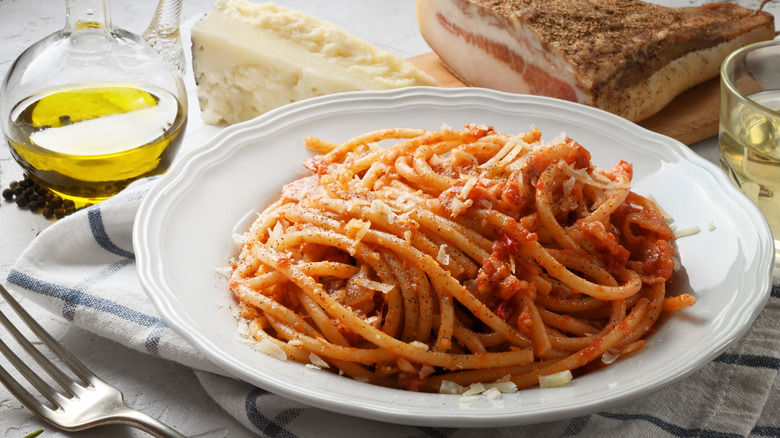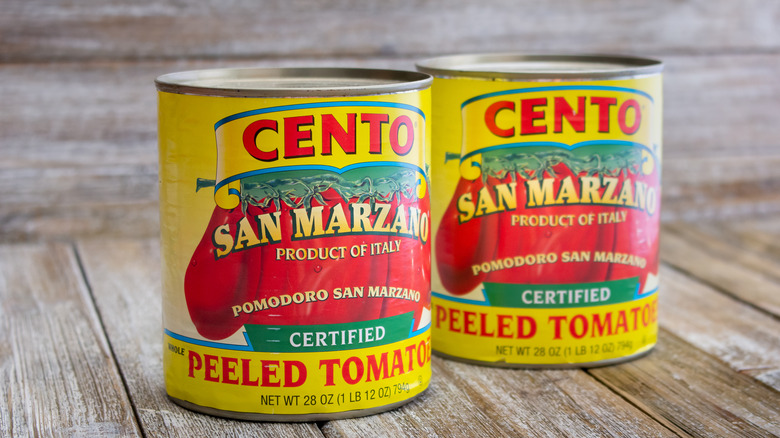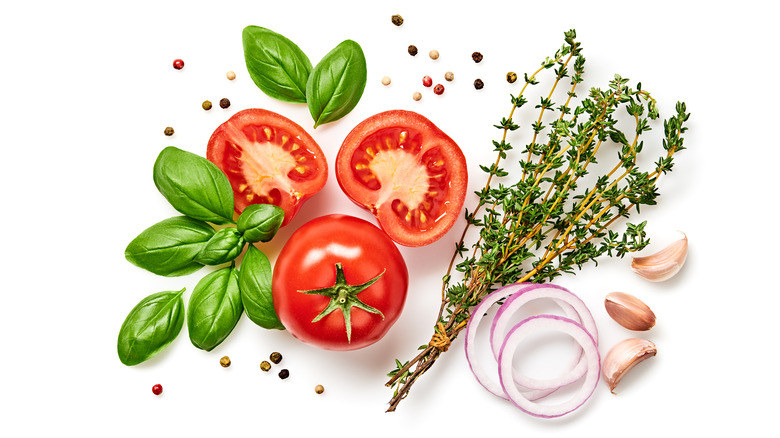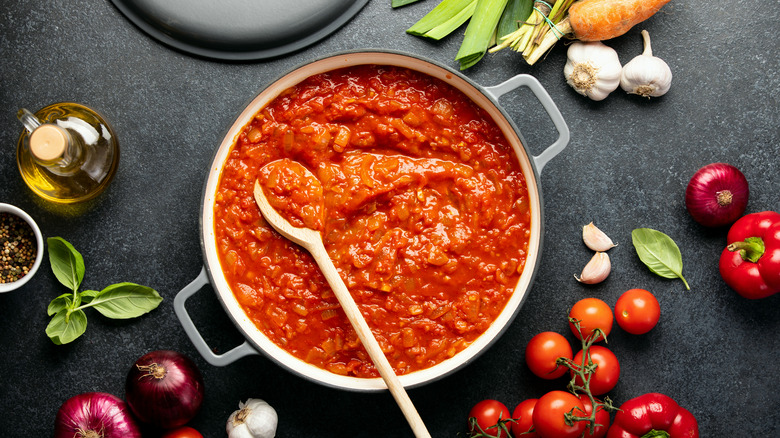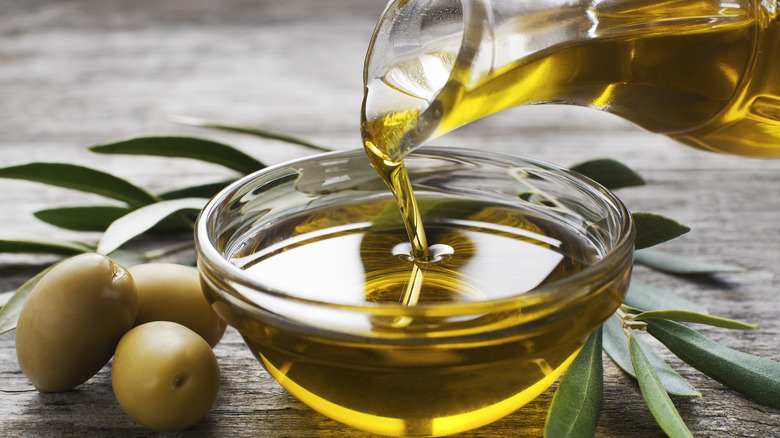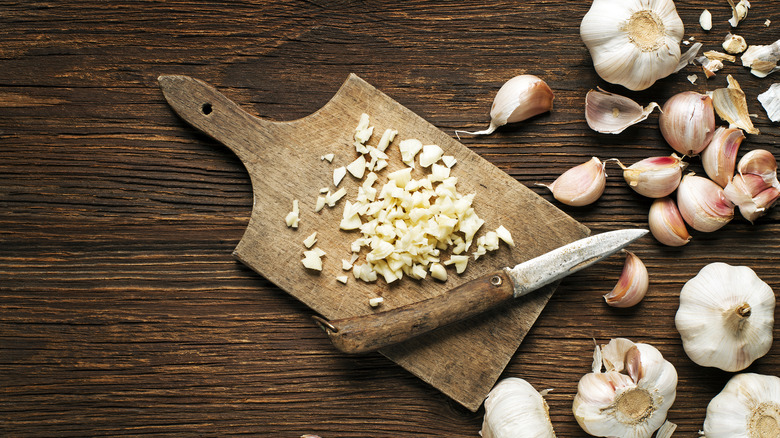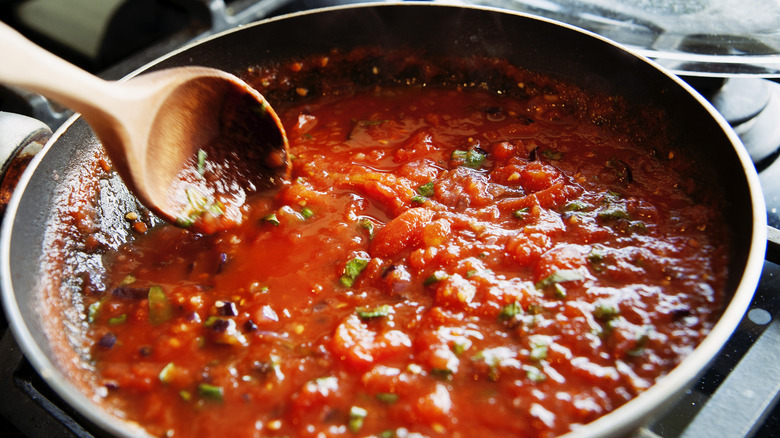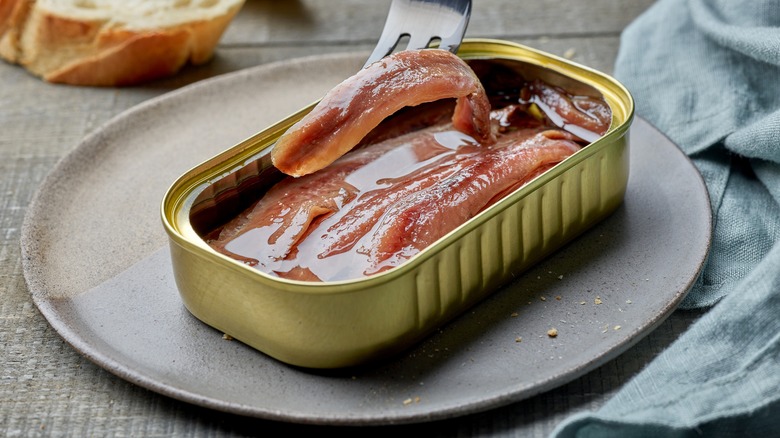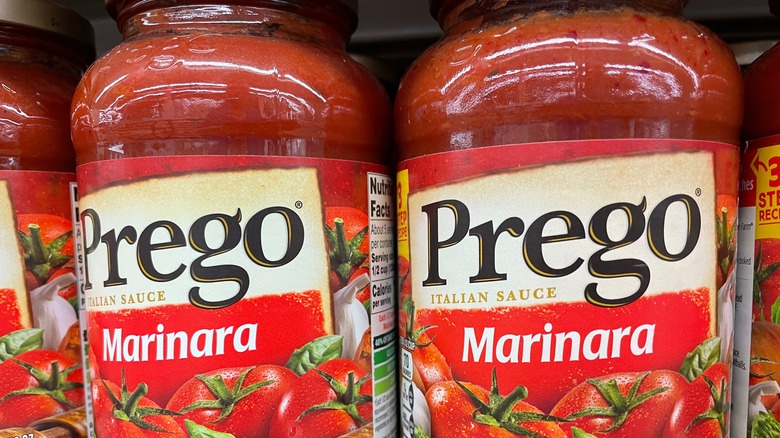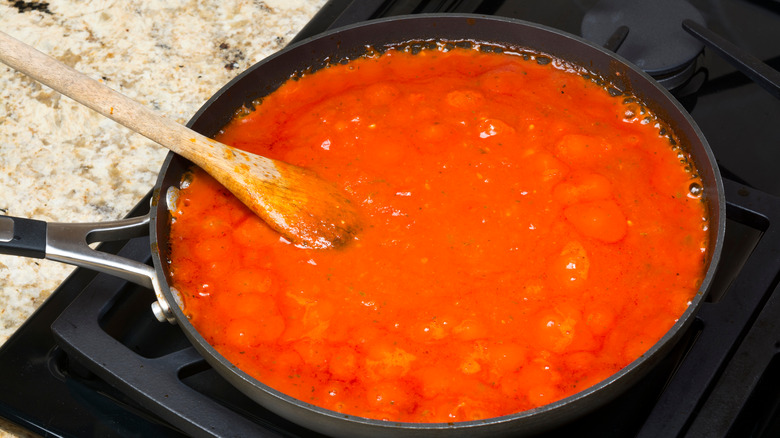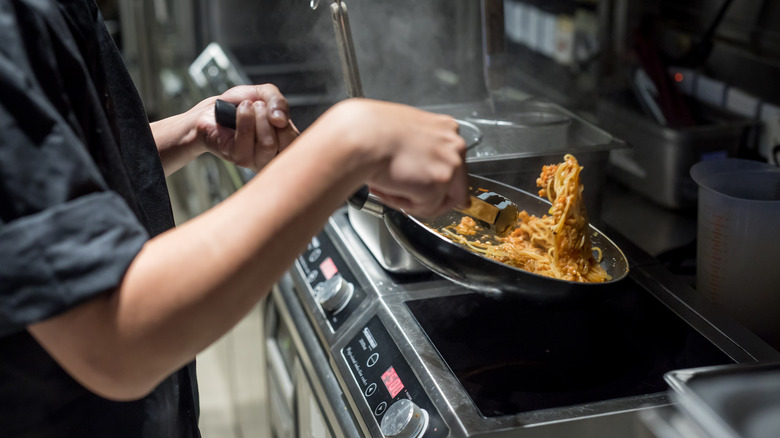12 Biggest Mistakes To Avoid With Spaghetti Sauce
Sitting down to a simple bowl of spaghetti in a well-made classic sauce is one of life's basic pleasures. Whether spinning the silky noodles with a slender fork and spoon or slurping it up with greedy abandon, the one thing aside from the pasta that can make or break your experience is the sauce. According to PBS, Asian noodles most likely arrived in the Mediterranean via nomadic Arabs before catching on in Italy. Aside from how inexpensive this new peasant food was, it was also a big hit because of how long it could be stored and how creative you could get with it.
Of course, Italy is known for growing and utilizing fresh herbs like basil and oregano, but tomatoes were also a crop well suited to Italy's growing environment. It shouldn't be any surprise that tomatoes would end up in a bowl of pasta.
When we think of sauce, our thoughts go toward the stalwart marinara. Marinara translates to "seafaring" in Italian, and considering marinara sauce got its name based on its popularity with seafaring merchants, it makes a lot of sense. So in recognition of the importance of a great sauce, let's talk about some mistakes to avoid with spaghetti sauce.
Choosing the wrong tomatoes
If we're talking about tomato sauce, there's nothing more important than the quality and type of tomatoes you use. That said, for an incredible spaghetti sauce, you need to look no further than the San Marzano Tomato.
According to Today, these specific tomatoes are more flavorful, less seedy than typical tomatoes, and packed with extra flavor. Special growing conditions related to healthy soil, access to water, and climate, affect the government-mandated designation — known as the DOP or Protected Designation of Origin — and the authenticity of every can of San Marzano tomatoes comes with a serial number and two identifying certifications. Because of the specific rules about what classifies as authentic San Marzano tomatoes — which include canning regulations that nix the use of any preservatives aside from salt or the occasional herb — a can of certified San Marzano can be a little pricey but still worth it. Better still, someone susceptible to acid reflux who typically avoids tomatoes because of their acidity should give San Marzano tomatoes a try. They have a lower acidity profile than standard tomatoes.
Stew them whole till they break down or purée them; either way, starting with the right tomato from the get-go makes a huge difference. Just keep in mind, although they are similar to Roma Tomatoes, the differences between San Marzano and Roma Tomatoes are vast in terms of what they work best for making. If we're talking sauce, San Marzano is the only way to go.
Seasoning with the wrong herbs
Now that we have our tomato base for the spaghetti sauce, it's imperative to know how to season it. One important tip you need when cooking with herbs revolves around fresh versus dried herbs. Living in a world where everything fresh is supposed to be better (and it oftentimes is), it's easy to understand why somebody's first impulse would be to pluck an oregano leaf from the garden for their sauce. However, all the time you spend watering that garden ends up as water in your herbs which impacts the flavor profile. In other words, most of the time, dried herbs edge out fresh ones in terms of the necessary punch for something like a sauce.
Before substituting dried herbs for fresh ones, it's best to recognize that some herbs that will be central to a tomato sauce can actually lose potency when dried. Sweet basil is one that you maybe don't want to switch out for a dried version, and as such, you will want to add it just before your sauce is finished cooking. Fresh herbs also don't do very well over extended cooking periods and can become astringent if cooked too long. If using a recipe incorporating fresh and dried herbs in your spaghetti sauce, use the one-third rule — substitute ⅓ of dry herbs for fresh since the flavors are more concentrated — and toss out dried herbs every six months to ensure an impactful taste.
Using the wrong cookware
Almost as bad as using the wrong ingredients is trying to make spaghetti sauce with the wrong cookware. It may be surprising, but even the interior color of your saucepan matters and can affect everything from how quickly your sauce cooks to the likelihood of it burning. Dark-colored saucepans are better conductors of heat, which cooks your sauce quicker but also makes noticing your sauce is burning a bit more challenging. On the other side of the spectrum, light-colored pans don't conduct heat as well, so they're great for longer cooking times and are less likely to leave the bottom of your pan looking like scorched earth.
Since spaghetti sauce is the goal, a good saucepan should be the obvious place to start. The Chicago Tribune suggests staying away from low-quality aluminum pans since the metal doesn't react well with different liquids and can potentially leave a tin flavor in your sauce. High-quality steel pans seem like the way to go since they are unlikely to burn the sauce because they don't heat up as well as aluminum. Size matters, so be sure to get the appropriately sized pan for the job. Since a good red sauce can splash, get a saucepan with a lid to keep both the heat and the sauce in the pan — the only place it belongs beside the spaghetti.
Cooking with the wrong oil
When it's time to make the sauce, going through all the trouble of avoiding the first three mistakes only to mess up the actual cooking process would be a real shame. Considering the best oil for the job is a necessity when talking about spaghetti sauce, that conversation has to turn to olive oil. There are marked differences between regular versus extra-virgin olive oil (EVOO). Much like wine, olive pomace is pressed without heat, or cold pressed, and the oil is extracted from that to create EVOO. Any oil below the high expectations of an extra-virgin classification gets used as cooking oil, a blend of extra-virgin olive oil and the lesser oil.
The best olive oils for cooking don't always end up in the U.S. because most of us weren't taught to know the difference between the good stuff and the low-quality oil other nations know enough not to stock. Some olive oils that are great for salads or bread — like EVOO — are not what a home saucier wants to be cooking their spaghetti sauce with. A few good examples of olive oil that would be perfect for spaghetti sauce would be Lucini Everyday Olive Oil and Pompeian Robust.
Burning the garlic
Now when it comes to how to cook with garlic, just throw a few chopped cloves of garlic into the oil. Where olive oil is concerned, though, keep it at low to medium temperature and stay attentive since garlic can burn in a flash. The size of garlic cloves used also comes into play here since the bigger the cloves, the harder they are to burn. They will still burn. HuffPost explains the reason garlic burns so rapidly is due to its lack of water content which gets even lower once you chop it into thin slivers. Not to put too fine a point on it, but always pay attention to the garlic in a saucepan, regardless of heat level.
Frankly, making spaghetti sauce without garlic is like eating a hot dog without mustard. It's just not done. According to The New York Times, raw garlic jump-starts your palate because of a molecule called allicin that stirs up other molecules and creates a party in your mouth in the same way wasabi does. That said, burning garlic in olive oil can have a pretty negative impact on the sauce and once the oil is imbued with the bitter taste, it will end up in everything cooked in the oil — including your sauce.
Making the wrong sauce
It's likely most people who are old hands at making spaghetti sauce would know the difference between tomato sauce and tomato paste. However, knowing the difference between tomato sauce and marinara sauce is just as important, but not necessarily as well understood. Tomato sauces are more complex than marinaras in cooking length, number of ingredients used, and flavor profile. As a sauce used to elevate stews and braised meats, it can be presented in a number of iterations, including vodka sauces and ragu sauces. Meanwhile, San Marzano tomatoes make up the base of any great marinara, and when blended with traditional ingredients like garlic and basil, marinara sauces are just flavorful enough to not overwhelm any of the other flavors in a dish.
As far as what makes the best spaghetti sauce goes, it depends on the needs of the cook. If the goal was to break down meat over several hours, like a beef stew or ragu, then tomato sauce is the best bet. For something quick and as understated as a basic pasta dish with two or three ingredients, a marinara will share the spotlight with other ingredients like herbs and olive oil quite nicely.
Skipping anchovies in a marinara
If going the route of a marinara, the last thing you should do with a sauce named after seafaring merchants is skipping the fish, especially if following a recipe that calls for anchovies. Anchovies have gotten a bad reputation from franchise pizza parlors using cheap, low-grade versions. But here's why you shouldn't skip the canned anchovies in your recipe. Good quality anchovies from a can give life to your puttanesca sauce. The best thing is, they fall apart easily in sauces, and are barely detectable texture-wise.
In terms of the best type of canned anchovies to add to your pasta sauce, professional chefs and food writers insist anchovies packed in olive oil are the way to go. Although anchovies are also jarred or canned as a paste or preserved in salt, the general consensus is that the best version of anchovies is packed in oil. Even Martha Stewart swears by anchovies in oil, going so far as to suggest drizzling the anchovy oil into the extra-virgin olive oil while sautéing your garlic and onions. When in doubt, especially when making a fantastic spaghetti sauce, we always stick with the advice from pros.
Not seasoning store bought sauce
Maybe getting your hands on San Marzano tomatoes or taking the time to prep them into a sauce isn't something you are into doing. Time constraints, hunger, and even confidence may keep making your own sauce from scratch too daunting. While there's nothing wrong with cheating with store-bought sauce, it's still necessary to add a pack of a little extra flavor into your sauce.
According to VICE, most companies mass-producing store-bought sauces use cheaper ingredients for seasoning as well as fresher ingredients, like torn basil, that degrade in taste when cooked. Considering the shelf life of store-bought sauces, it's safe to assume that by the time it gets to your saucepan, it has already lost most of its flavor. The fix for this is to season with some of the herbs already mentioned, and if you can take the heat, toss some chili flakes in, too.
Of course, one way to make things easier is to grab the best store-bought pasta sauce on the market and go from there. In a survey of 626 readers, 37% of all votes overwhelmingly went to Prego sauce. So if store-bought sauce has to be the way to go, we've just given you an idea of which brand to grab and how to make it even better.
Leaving out butter
Some ideas aren't necessarily mistakes, but not doing them can be such a misstep that they practically are. That's sort of what leaving butter out of your sauce is like. You should consider adding a little butter to your pasta sauce when the sauce is just about done. The best way to do it is in combination with your pasta water, which should be good and starchy before adding some of it to your nearly completed sauce. The melted fat and starch combine to become a thickener for your spaghetti sauce, and you can use as much as you need to get a creamier sauce.
Out of butter? A life hack we've come up with is to substitute cornstarch for butter in pasta sauce. While cornstarch alone will act as a thickening agent for the sauce, a good EVOO — the finishing kind, not the cooking kind — makes for a great, peppery stand-in for butter. Cornstarch mixed separately in a bowl with pasta water makes for a miracle emulsifier, just make sure the mixture is added after the olive oil. Whether emulsified with butter and pasta water or cornstarch and olive oil, it won't take very long to realize butter — or a substitute version — was missing from your life and your spaghetti sauce.
Overcooking the sauce
When it comes to the matter of overcooking, the biggest mistake you're probably making with marinara sauce is the length of time it's cooking on the stove. For those of us not raised in an Italian household, what is perceived as the amount of work needed to make a great sauce may come from movies. While the jury is still out on whether the Goodfellas prison pasta sauce would really be possible, one thing that's inarguable is the hours it would have taken to make it. As far as a simple meatless marinara goes, the total cooking time shouldn't ever extend past 20 minutes. Just cover the saucepan partially with a lid so the sauce doesn't dry out while it sits on a rapid simmer.
A traditional marinara sauce for your spaghetti, much like your spaghetti, doesn't need hours of preparation to be fabulous. Even though it's been mentioned that one of the differences between marinara sauce and tomato sauce is related to cooking time, it's entirely possible to make a fast no-cook tomato sauce with lemon and oregano in a pinch. A can of DOP San Marzano tomatoes, chili flakes, and lemon zest leads to a punchy, oregano-tinged red sauce with a fresh hint of citrus. Best of all is this spaghetti sauce doable in less than 15 minutes.
Not letting the sauce rest
By now, most people have heard the age-old adage around grilling or searing meat — let the meat rest. Well, there's a serious case to be made for why it's important to let the marinara sauce rest after cooking, and after all the work put into getting the sauce to this point, it would be poor form to make the mistake of not letting it rest. This may seem counterintuitive after our last bit of advice, but something to keep in mind is how flavor works its way into your food.
There's a prevailing science that suggests a sauce marries more flavors together over time. Ingredients like garlic, basil, oregano, and the Italian terroir of the San Marzano tomatoes come out as the natural sugars caramelize in the sauce together. According to BBC Science Focus, stews and soups do so well with low and long cooking is related to how prolonged heat breaks down food molecules. Whether talking about meat or vegetables, food molecules free up flavor over time. Research also points to a particular psychology at play affecting how we perceive the taste of food we've just prepared based on our olfactory senses — we get used to the smell of something as we prepare it, so the second time around it tastes better with a fresh nose and less labor. So though it doesn't require hours to prepare a marinara, make it today and leave it in the fridge overnight for dinner tomorrow.
Adding sauce to fully cooked spaghetti
So now, the sauce is perfect. It's rested with all the flavors broken down and released into the marinara. That's fantastic, but if you toss fully cooked spaghetti into your pasta, you have already missed an important flavor window. The best way to get the most flavor out of your spaghetti is to take it out of the pasta water about four minutes before it's fully done. What we are looking for is to finish the al dente spaghetti in the actual sauce.
The real reason you should always finish your pasta in the sauce goes back to the thickening of the sauce and enhanced taste. The starch from the noodles grabs hold of the sauce and guarantees all of the flavors hit your tastebuds with every mouthful. The fat and acid from the pasta water and spaghetti also emulsify the sauce so you get perfectly cooked sauce and magnificently sauced spaghetti noodles. A good rule of thumb is to deduct the aforementioned four minutes from the spaghetti's cooking time and finish it in the pasta under a 30/70 rule — cook your spaghetti 70% in the pasta water and 30% in the sauce — for perhaps the best bowl of spaghetti in the sauce you've ever experienced.
